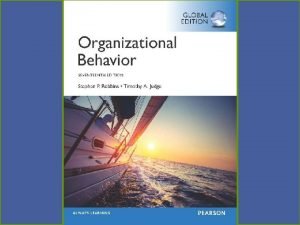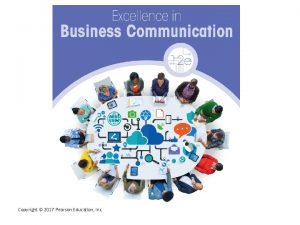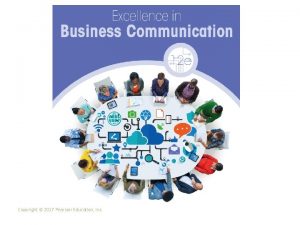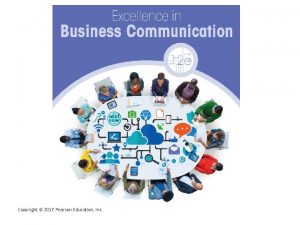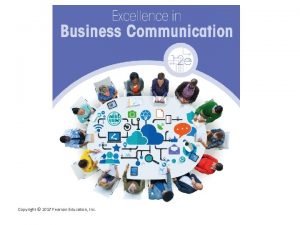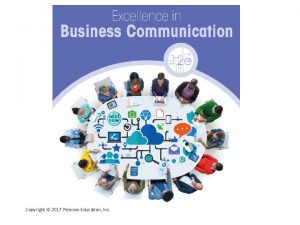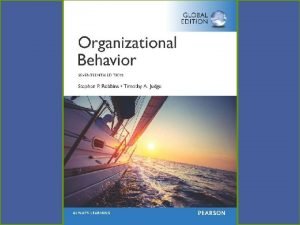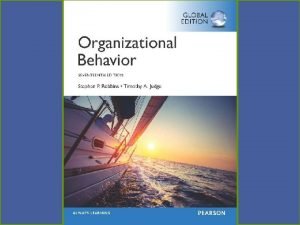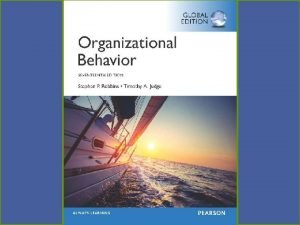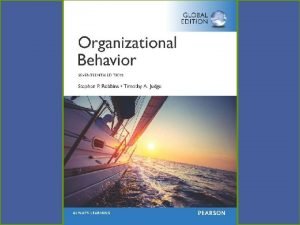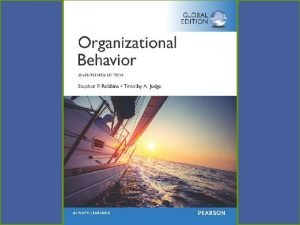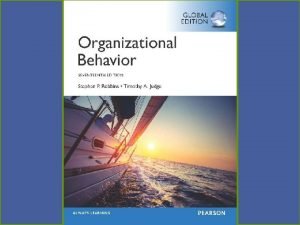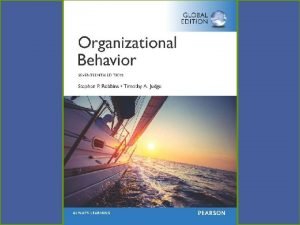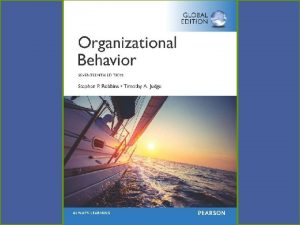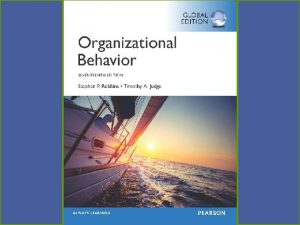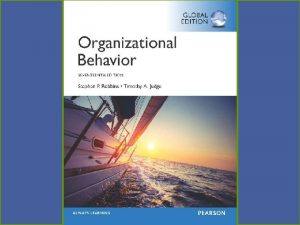Copyright 2017 Pearson Education Ltd 9 1 9
































- Slides: 32

Copyright © 2017 Pearson Education, Ltd. 9 -1

9 Foundations of Individual Behavior Copyright © 2017 Pearson Education, Ltd. 9 -2

Learning Outcomes q. Identify the focus and goals of organizational behavior (OB). q. Explain the role that attitudes play in job performance. q. Describe different personality theories. q. Describe perception and the factors that influence it. q. Discuss learning theories and their relevance in shaping behavior. q. Discuss contemporary issues in OB. Copyright © 2017 Pearson Education, Ltd. 9 -3

9 -1 Identify the focus and goals of organizational behavior (OB). Copyright © 2017 Pearson Education, Ltd. 9 -4

Organizational Behavior Copyright © 2017 Pearson Education, Ltd. 9 -5

Goals of Organizational Behavior 1. 2. 3. 4. 5. 6. Employee productivity Absenteeism Turnover Organizational citizenship behavior Job satisfaction Workplace misbehavior Copyright © 2017 Pearson Education, Ltd. 9 -6

9 -2 Explain the role that attitudes play in job performance. Copyright © 2017 Pearson Education, Ltd. 9 -7

Attitudes and Job Performance • • Job satisfaction Job involvement Organizational commitment Employee engagement Copyright © 2017 Pearson Education, Ltd. 9 -8

Attitudes and Consistency Cognitive dissonance: any incompatibility or inconsistency between attitudes or between behavior and attitudes. Copyright © 2017 Pearson Education, Ltd. 9 -9

Understanding Attitudes n Satisfied employees have lower rates of turnover and absenteeism n Satisfied employees perform better on the job n Survey employees about their attitudes n Employees will try to reduce dissonance. Copyright © 2017 Pearson Education, Ltd. 9 -10

9 -3 Describe different personality theories. Copyright © 2017 Pearson Education, Ltd. 9 -11

Personality Theories Personality: a unique combination of emotional, thought, and behavioral patterns that affect how a person reacts to situations and interacts with others. Copyright © 2017 Pearson Education, Ltd. 9 -12

Big Five Model of Personality The Big Five factors are: 1. Extraversion 2. Agreeableness 3. Conscientious 4. Emotional stability 5. Openness to experience Copyright © 2017 Pearson Education, Ltd. 9 -13

Emotional Intelligence Five dimensions: • Self-awareness • Self-management • Self-motivation • Empathy • Social skills Copyright © 2017 Pearson Education, Ltd. 9 -14

Personality Traits Can personality traits predict practical work-related behaviors? Yes! Copyright © 2017 Pearson Education, Ltd. 9 -15

Matching Personalities and Jobs Copyright © 2017 Pearson Education, Ltd. 9 -16

Personality Traits Across Cultures National cultures differ in terms of the degree to which people believe they control their environment. Copyright © 2017 Pearson Education, Ltd. 9 -17

Understanding Personality 1. Job-person compatibility 2. Understanding different approaches to work 3. Being a better manager Copyright © 2017 Pearson Education, Ltd. 9 -18

9 -4 Describe perception and the factors that influence it. Copyright © 2017 Pearson Education, Ltd. 9 -19

Perception Copyright © 2017 Pearson Education, Ltd. 9 -20

Judging Employees Copyright © 2017 Pearson Education, Ltd. 9 -21

Distorted Attributions Fundamental attribution error: the tendency to underestimate the influence of external factors and overestimate the influence of internal factors when making judgments about the behavior of others. Self-serving bias: the tendency for individuals to attribute their successes to internal factors while putting the blame for failures on external factors. Copyright © 2017 Pearson Education, Ltd. 9 -22

Perceptual Shortcuts Copyright © 2017 Pearson Education, Ltd. 9 -23

Understanding Perception • Employees react to perception, not reality • The potential for perceptual distortion exists Copyright © 2017 Pearson Education, Ltd. 9 -24

9 -5 Discuss learning theories and their relevance in shaping behavior. Copyright © 2017 Pearson Education, Ltd. 9 -25

Operant Conditioning Copyright © 2017 Pearson Education, Ltd. 9 -26

Social Learning Theory Learning both through: observation and direct experience Copyright © 2017 Pearson Education, Ltd. 9 -27

Shaping Behavior 1. 2. 3. 4. Positive reinforcement Negative reinforcement Punishment Extinction Copyright © 2017 Pearson Education, Ltd. 9 -28

Managing Employees’ Learning • Watch what you reward • Watch what you do Copyright © 2017 Pearson Education, Ltd. 9 -29

9 -6 Discuss contemporary issues in OB. Copyright © 2017 Pearson Education, Ltd. 9 -30

Contemporary Issues Copyright © 2017 Pearson Education, Ltd. 9 -31

Negative Behavior in the Workplace Survey of U. S. Employees: • 10% witnessed rudeness daily • 20% were targets of incivility at least once/week Copyright © 2017 Pearson Education, Ltd. 9 -32
 Pearson education ltd 2017
Pearson education ltd 2017 Pearson education limited 2017
Pearson education limited 2017 Pearson education ltd 2017
Pearson education ltd 2017 2017 pearson education inc
2017 pearson education inc 2010 pearson education inc
2010 pearson education inc 2009 pearson education inc
2009 pearson education inc 2018 pearson education inc
2018 pearson education inc Copyright 2014 pearson education inc
Copyright 2014 pearson education inc Copyright 2010 pearson education inc
Copyright 2010 pearson education inc Copyright 2010 pearson education inc
Copyright 2010 pearson education inc Copyright by pearson education inc. answers
Copyright by pearson education inc. answers 2008 pearson education inc
2008 pearson education inc Copyright 2009 pearson education inc
Copyright 2009 pearson education inc Copyright pearson education inc
Copyright pearson education inc Copyright 2010 pearson education inc
Copyright 2010 pearson education inc Copyright 2010 pearson education inc
Copyright 2010 pearson education inc Copyright 2010 pearson education inc
Copyright 2010 pearson education inc Copyright 2010 pearson education inc
Copyright 2010 pearson education inc Copyright 2010 pearson education inc
Copyright 2010 pearson education inc Copyright 2010 pearson education inc
Copyright 2010 pearson education inc Pearson education inc all rights reserved
Pearson education inc all rights reserved Copyright 2009 pearson education inc
Copyright 2009 pearson education inc 2009 pearson education inc
2009 pearson education inc 2009 pearson education inc
2009 pearson education inc 2009 pearson education inc
2009 pearson education inc Copyright pearson education inc
Copyright pearson education inc 2017 pearson education inc
2017 pearson education inc 2017 pearson education inc
2017 pearson education inc 2017 pearson education inc
2017 pearson education inc 2017 pearson education inc
2017 pearson education inc 2017 pearson education inc
2017 pearson education inc Pearson education 2017
Pearson education 2017 2017 pearson education inc
2017 pearson education inc
